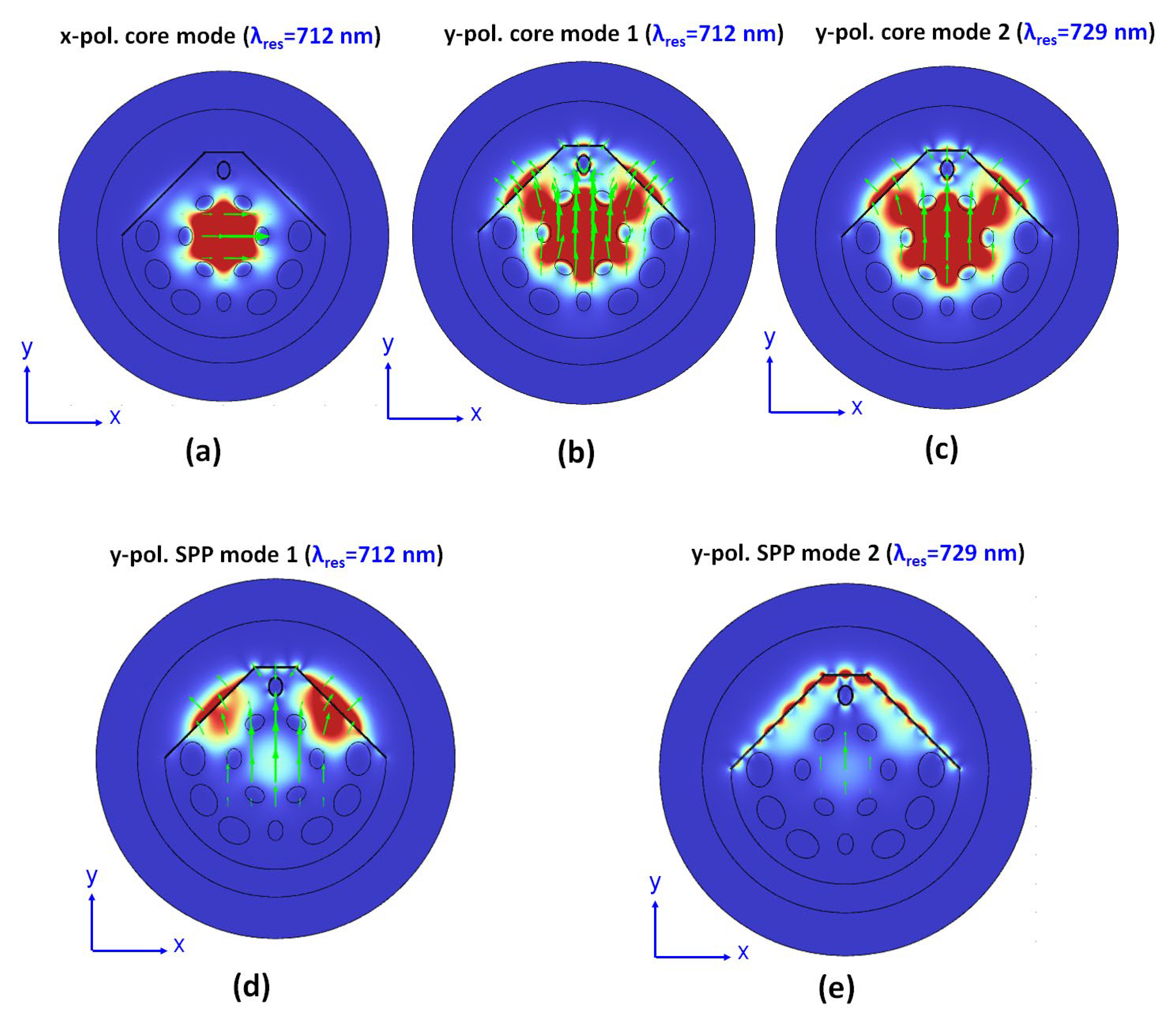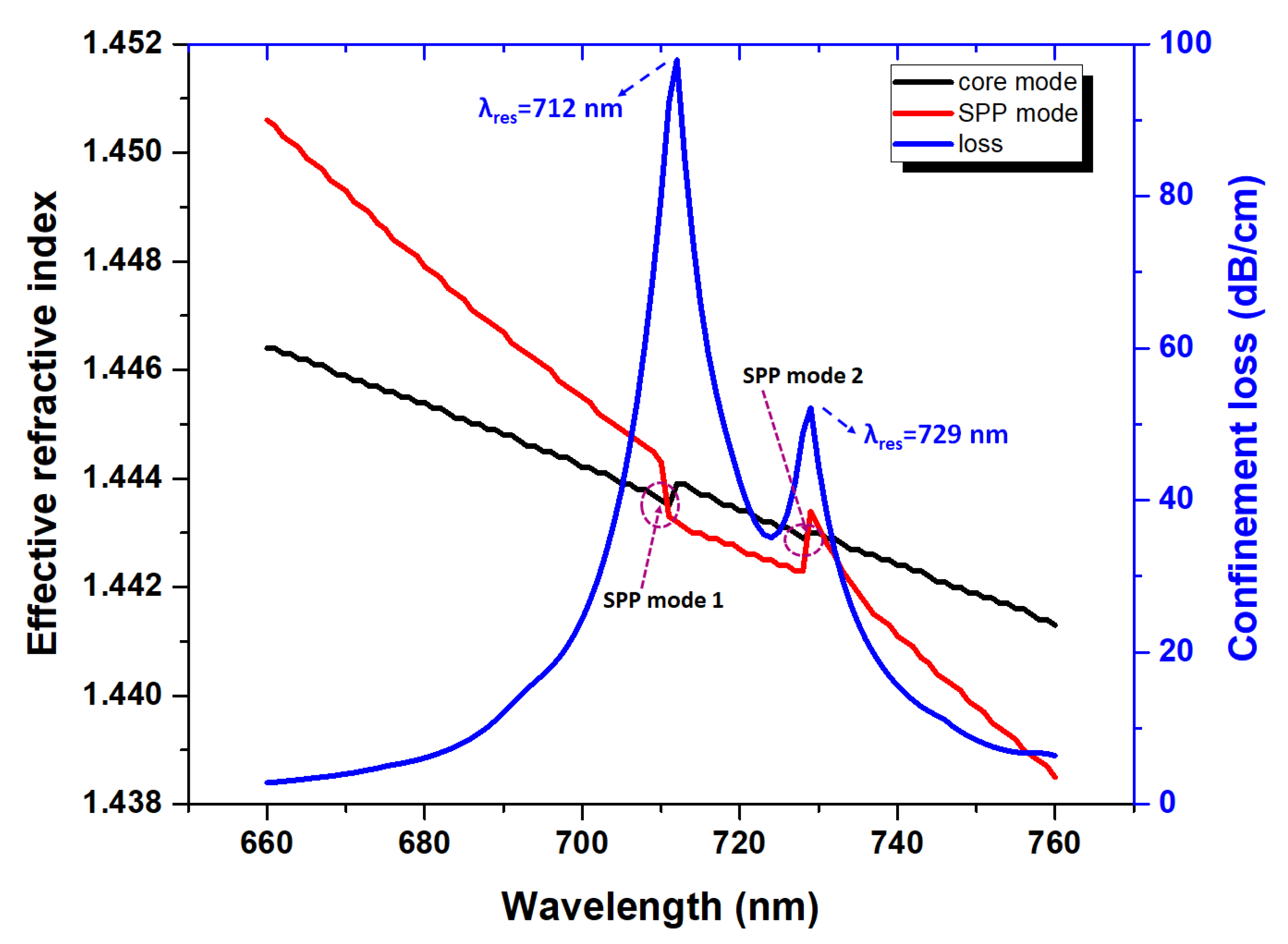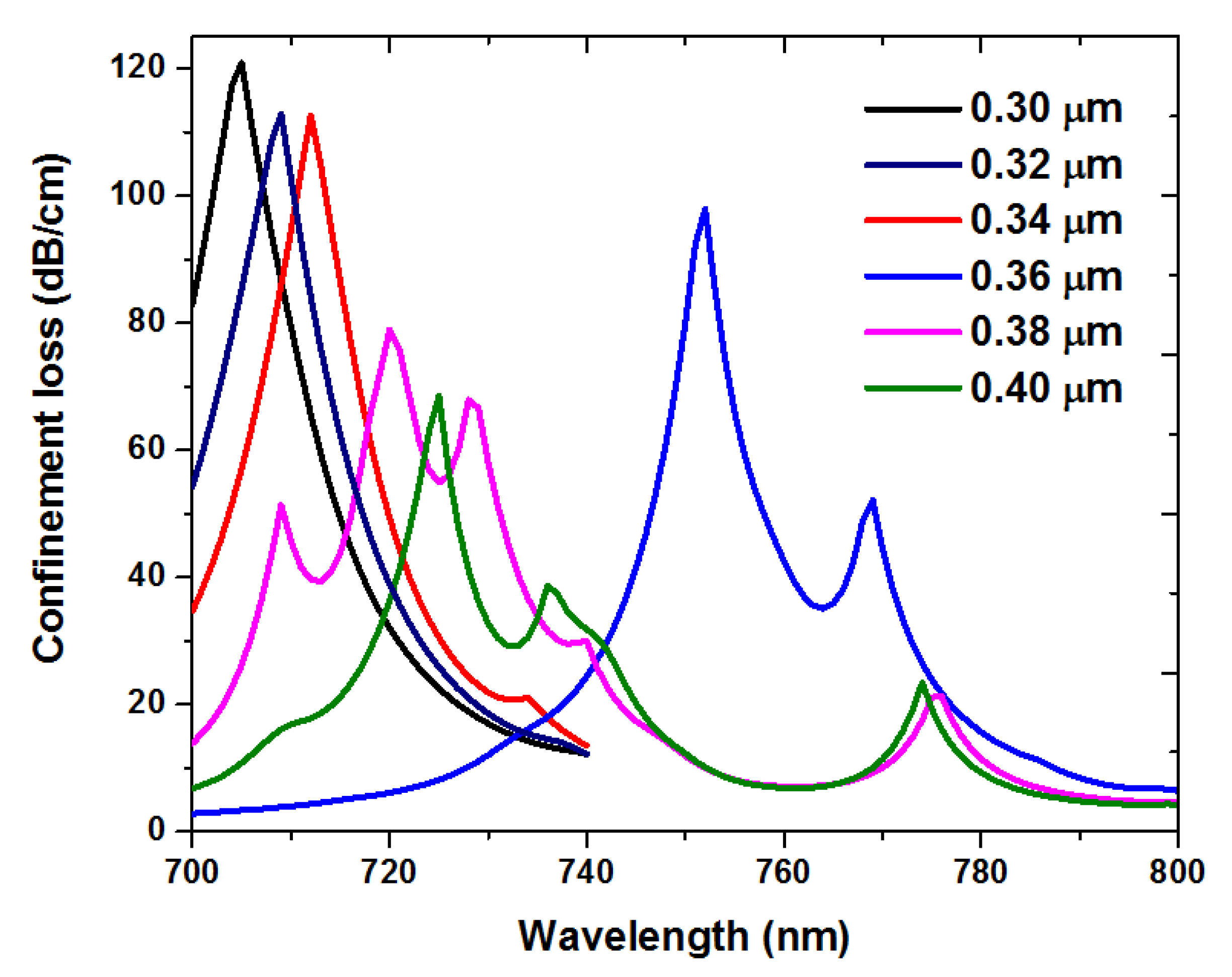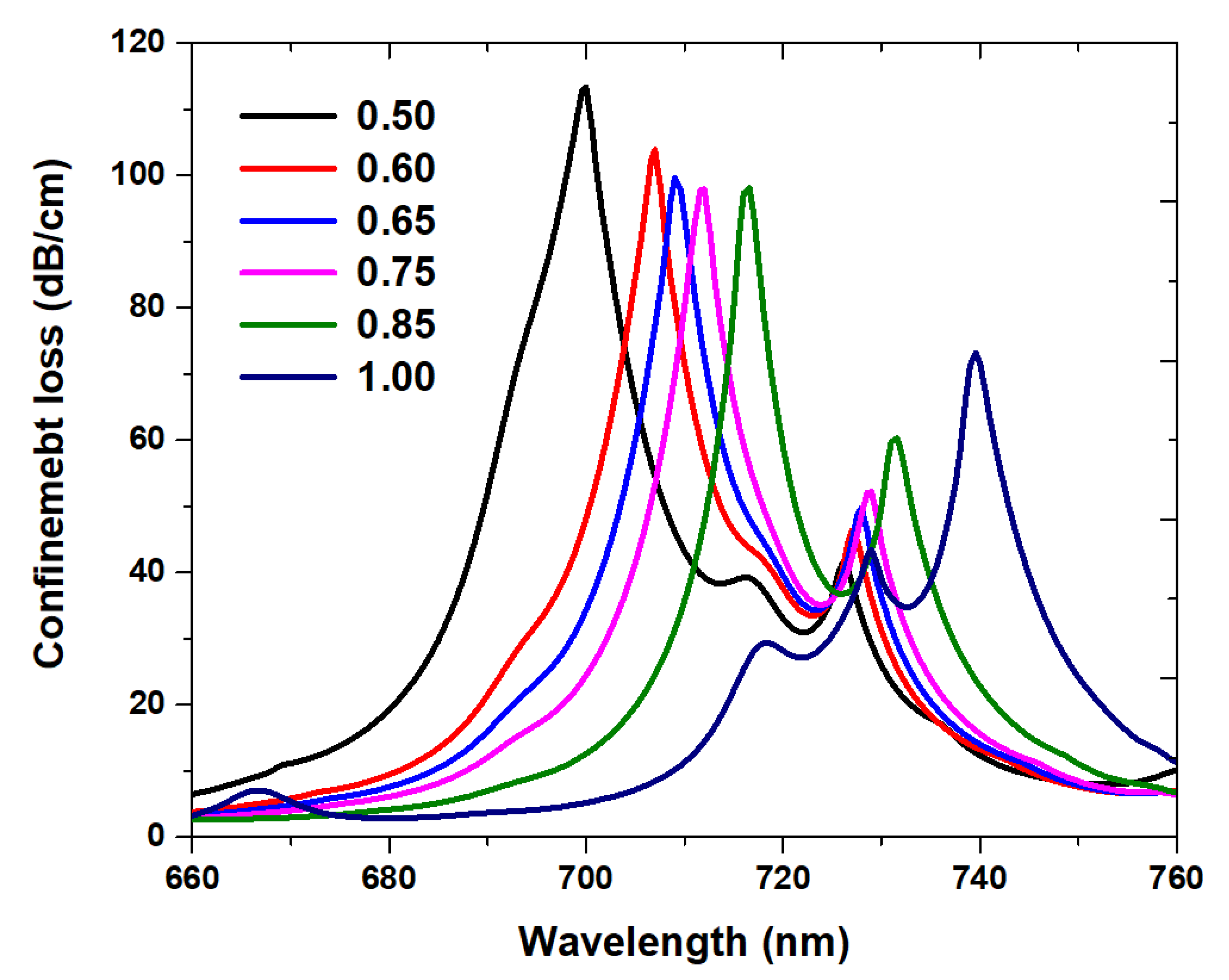Improving Temperature-Sensing Performance of Photonic Crystal Fiber via External Metal-Coated Trapezoidal-Shaped Surface
Abstract
:1. Introduction
2. Materials and Methods
3. Results and Discussion
4. Conclusions
Author Contributions
Funding
Data Availability Statement
Acknowledgments
Conflicts of Interest
References
- Hirbodvash, Z.; Berini, P. Surface Plasmon Electrochemistry: Tutorial and Review. Chemosensors 2023, 11, 196. [Google Scholar] [CrossRef]
- Jawad, A.; Arifuzzaman, S.; Anower, M.S.; Ferdous, A.H.M.I.; Anwer, T.M.K.; Ahammad, S.H.; Hossain, A.; Rashed, A.N.Z. Modeling and Performance Analysis of an Advanced Hybrid Surface Plasmon Resonance (SPR) Sensor Employing Indium Tin Oxide-Phosphorene Hetero Structure. Plasmonics 2023, 1–11. [Google Scholar] [CrossRef]
- Altug, H.; Oh, S.-H.; Maier, S.A.; Homola, J. Advances and applications of nanophotonic biosensors. Nat. Nanotechnol. 2022, 17, 5–16. [Google Scholar] [CrossRef] [PubMed]
- Choi, S.H.; Kim, Y.L.; Byun, K.M. Graphene-on-silver substrates for sensitive surface plasmon resonance imaging biosensors. Opt. Express 2011, 19, 458–466. [Google Scholar] [CrossRef]
- Barnes, W.L.; Dereux, A.; Ebbesen, T.W. Surface plasmon subwavelength optics. Nature 2003, 424, 824–830. [Google Scholar] [CrossRef]
- Tagliabue, G.; Jermyn, A.S.; Sundararaman, R.; Welch, A.J.; DuChene, J.S.; Pala, R.; Davoyan, A.R.; Narang, P.; Atwater, H.A. Quantifying the role of surface plasmon excitation and hot carrier transport in plasmonic devices. Nat. Commun. 2018, 9, 3394. [Google Scholar] [CrossRef]
- Butt, M.A.; Khonina, S.N.; Kazanskiy, N.L. Plasmonics: A Necessity in the Field of Sensing-A Review (Invited). Fiber Integr. Opt. 2021, 40, 14–47. [Google Scholar] [CrossRef]
- Zhang, Q.; Li, W.; Ren, Q.; Zheng, J.; Xie, Q.; Wang, X. A D-type dual side-polished, highly sensitive, plasma refractive index sensor based on photonic crystal fiber. Front. Phys. 2022, 10, 1008784. [Google Scholar] [CrossRef]
- An, G.; Hao, X.; Li, S.; Yan, X.; Zhang, X. D-shaped photonic crystal fiber refractive index sensor based on surface plasmon resonance. Appl. Opt. 2017, 56, 6988–6992. [Google Scholar] [CrossRef]
- Lou, J.; Cheng, T.; Li, S.; Zhang, X. Surface plasmon resonance photonic crystal fiber biosensor based on gold-graphene layers. Opt. Fiber Technol. 2019, 50, 206–211. [Google Scholar] [CrossRef]
- Akter, S.; Rahman, M.Z.; Mahmud, S. Highly sensitive open-channels based plasmonic biosensor in visible to near-infrared wavelength. Results Phys. 2019, 13, 102328. [Google Scholar] [CrossRef]
- Sardar, M.R.; Faisal, M.J.J.o.S.T. Methane gas sensor based on microstructured highly sensitive hybrid porous core photonic crystal fiber. J. Sens. Technol. 2019, 9, 12–26. [Google Scholar] [CrossRef]
- Rifat, A.A.; Ahmed, K.; Asaduzzaman, S.; Paul, B.K.; Ahmed, R. Development of Photonic Crystal Fiber-Based Gas/Chemical Sensors. In Computational Photonic Sensors; Hameed, M.F.O., Obayya, S., Eds.; Springer International Publishing: Cham, Switzerland, 2019; pp. 287–317. [Google Scholar]
- Rifat, A.A.; Ahmed, R.; Yetisen, A.K.; Butt, H.; Sabouri, A.; Mahdiraji, G.A.; Yun, S.H.; Adikan, F.R.M. Photonic crystal fiber based plasmonic sensors. Sens. Actuators B Chem. 2017, 243, 311–325. [Google Scholar] [CrossRef]
- Danlard, I.; Akowuah, E.K.J.O.F.T. Assaying with PCF-based SPR refractive index biosensors: From recent configurations to outstanding detection limits. Opt. Fiber Technol. 2020, 54, 102083. [Google Scholar] [CrossRef]
- Saber, A.M.; Hameed, M.F.O.; El-Azab, J.; Amer, R.Y.; Ismail, T.; Obayya, S. Plasmonic photonic crystal fiber sensor for optical partial discharge detection. Opt. Quantum Electron. 2022, 54, 1–17. [Google Scholar] [CrossRef]
- Aruna Gandhi, M.S.; Senthilnathan, K.; Babu, P.R.; Li, Q. Visible to near infrared highly sensitive microbiosensor based on surface plasmon polariton with external sensing approach. Results Phys. 2019, 15, 102590. [Google Scholar] [CrossRef]
- Liu, C.; Lü, J.; Liu, W.; Wang, F.; Chu, P. Overview of refractive index sensors comprising photonic crystal fibers based on the surface plasmon resonance effect. Chin. Opt. Lett. 2021, 19, 102202. [Google Scholar] [CrossRef]
- Wang, Y.; Jiang, G.; Yu, Z.; Wang, Q.; Jiang, X. Trapezium-shaped groove photonic crystal fiber plasmon sensor for low refractive index detection. Sens. Bio-Sens. Res. 2021, 34, 100452. [Google Scholar] [CrossRef]
- Wang, X.; Deng, H.; Yuan, L. Ultra-high sensitivity SPR temperature sensor based on a helical-core fiber. Opt. Express 2021, 29, 22417–22426. [Google Scholar] [CrossRef]
- Chao, C.-T.C.; Kooh, M.R.R.; Chau, Y.-F.C.; Thotagamuge, R. Susceptible Plasmonic Photonic Crystal Fiber Sensor with Elliptical Air Holes and External-Flat Gold-Coated Surface. Photonics 2022, 9, 916. [Google Scholar] [CrossRef]
- Najafzadeh, A.; Wong, L.; Gunawardena, D.S.; Tran, T.; Fu, J.; Chen, B.K.; Cheng, X.; Tam, H.-Y. Biomechanical assessment and quantification of femur healing process using fibre Bragg grating strain sensors. Sens. Actuators A Phys. 2022, 347, 113930. [Google Scholar] [CrossRef]
- Han, H.; Hou, D.; Luan, N.; Bai, Z.; Song, L.; Liu, J.; Hu, Y. Surface Plasmon Resonance Sensor Based on Dual-Side Polished Microstructured Optical Fiber with Dual-Core. Sensors 2020, 20, 3911. [Google Scholar] [CrossRef] [PubMed]
- Phan, Q.-H.; Lai, Y.-R.; Xiao, W.-Z.; Pham, T.-T.-H.; Lien, C.-H. Surface plasmon resonance prism coupler for enhanced circular birefringence sensing and application to non-invasive glucose detection. Opt. Express 2020, 28, 24889–24899. [Google Scholar] [CrossRef] [PubMed]
- Rakhshani, M.R.; Tavousi, A.; Mansouri-Birjandi, M.A. Design of a plasmonic sensor based on a square array of nanorods and two slot cavities with a high figure of merit for glucose concentration monitoring. Appl. Opt. 2018, 57, 7798–7804. [Google Scholar] [CrossRef] [PubMed]
- Antunes, P.; Lima, H.; Alberto, N.; Bilro, L.; Pinto, P.; Costa, A.; Rodrigues, H.; Pinto, J.L.; Nogueira, R.; Varum, H.; et al. Optical Sensors Based on Fiber Bragg Gratings for Structural Health Monitoring. In New Developments in Sensing Technology for Structural Health Monitoring; Mukhopadhyay, S.C., Ed.; Springer: Berlin/Heidelberg, Germany, 2011; pp. 253–295. [Google Scholar]
- Dong, X.; Tam, H.Y.; Shum, P. Temperature-insensitive strain sensor with polarization-maintaining photonic crystal fiber based Sagnac interferometer. Appl. Phys. Lett. 2007, 90, 151113. [Google Scholar] [CrossRef]
- Sarker, H.; Alam, F.; Khan, M.R.; Mollah, M.A.; Hasan, M.L.; Rafi, A.B.M.S. Designing highly sensitive exposed core surface plasmon resonance biosensors. Opt. Mater. Express 2022, 12, 1977–1990. [Google Scholar] [CrossRef]
- Wang, J.; Liu, C.; Wang, F.; Su, W.; Yang, L.; Lv, J.; Fu, G.; Li, X.; Liu, Q.; Sun, T.; et al. Surface plasmon resonance sensor based on coupling effects of dual photonic crystal fibers for low refractive indexes detection. Results Phys. 2020, 18, 103240. [Google Scholar] [CrossRef]
- Marshall, G.D.; Kan, D.J.; Asatryan, A.A.; Botten, L.C.; Withford, M.J. Transverse coupling to the core of a photonic crystal fiber: The photo-inscription of gratings. Opt. Express 2007, 15, 7876–7887. [Google Scholar] [CrossRef]
- Drljača, B.; Savović, S.; Kovačević, M.S.; Simović, A.; Kuzmanović, L.; Djordjevich, A.; Min, R. Theoretical Investigation of Bandwidth in Multimode Step-Index Silica Photonic Crystal Fibers. Photonics 2022, 9, 214. [Google Scholar] [CrossRef]
- Shakya, A.K.; Ramola, A.; Singh, S.; Van, V. Design of an ultra-sensitive bimetallic anisotropic PCF SPR biosensor for liquid analytes sensing. Opt. Express 2022, 30, 9233–9255. [Google Scholar] [CrossRef]
- Islam, M.R.; Khan, M.M.I.; Al Rafid, R.; Mehjabin, F.; Rashid, M.S.; Chowdhury, J.A.; Zerin, N.; Islam, M. Trigonal cluster-based ultra-sensitive surface plasmon resonance sensor for multipurpose sensing. Sens. Bio-Sens. Res. 2022, 35, 100477. [Google Scholar] [CrossRef]
- Duan, L.; Yang, X.; Lu, Y.; Yao, J. Hollow-fiber-based surface plasmon resonance sensor with large refractive index detection range and high linearity. Appl. Opt. 2017, 56, 9907–9912. [Google Scholar] [CrossRef]
- Yan, X.; Wang, Y.; Cheng, T.; Li, S. Photonic Crystal Fiber SPR Liquid Sensor Based on Elliptical Detective Channel. Micromachines 2021, 12, 408. [Google Scholar] [CrossRef] [PubMed]
- Rifat, A.A.; Haider, F.; Ahmed, R.; Mahdiraji, G.A.; Mahamd Adikan, F.R.; Miroshnichenko, A.E. Highly sensitive selectively coated photonic crystal fiber-based plasmonic sensor. Opt. Lett. 2018, 43, 891–894. [Google Scholar] [CrossRef]
- Li, T.; Zhu, L.; Yang, X.; Lou, X.; Yu, L. A Refractive Index Sensor Based on H-Shaped Photonic Crystal Fibers Coated with Ag-Graphene Layers. Sensors 2020, 20, 741. [Google Scholar] [CrossRef]
- Mei, C.; Wu, Y.; Qiu, S.; Yuan, J.; Zhou, X.; Long, K. Design of dual-core photonic crystal fiber for temperature sensor based on surface plasmon resonance effect. Opt. Commun. 2022, 508, 127838. [Google Scholar] [CrossRef]
- Rahman, M.T.; Datto, S.; Sakib, M.N. Highly sensitive circular slotted gold-coated micro channel photonic crystal fiber based plasmonic biosensor. OSA Contin. 2021, 4, 1808–1826. [Google Scholar] [CrossRef]
- Yang, X.; Lu, Y.; Liu, B.; Yao, J. Simultaneous measurement of refractive index and temperature based on SPR in D-shaped MOF. Appl. Opt. 2017, 56, 4369–4374. [Google Scholar] [CrossRef]
- Wang, S.; Lu, Y.; Ma, W.; Liu, N.; Fan, S. D-Shaped Surface Plasmon Photonic Crystal Fiber Temperature Sensor. Plasmonics 2022, 17, 1–9. [Google Scholar] [CrossRef]
- Kumar Vyas, A.; Kumar Gangwar, R.; Kumar, S. Elliptical air hole PCF-based low-cost sensor for refractive index and temperature detection: Design and analysis. Opt. Fiber Technol. 2022, 73, 103060. [Google Scholar] [CrossRef]
- Abdullah, H.; Islam, M.R.; Ahmed, K.; Malka, D.; Nguyen, T.K.; Hossain, M.N.; Paul, B.K.; Dhasarathan, V. Theoretical analysis of highly temperature-sensitive fem based optical sensor in the infrared range. Optik 2020, 205, 164060. [Google Scholar] [CrossRef]
- Xu, Y.; Chen, X.; Zhu, Y. High Sensitive Temperature Sensor Using a Liquid-core Optical Fiber with Small Refractive Index Difference Between Core and Cladding Materials. Sensors 2008, 8, 1872–1878. [Google Scholar] [CrossRef] [PubMed]
- Zhang, Y.; Chen, H.; Wang, M.; Liu, Y.; Fan, X.; Chen, Q.; Wu, B. Simultaneous measurement of refractive index and temperature of seawater based on surface plasmon resonance in a dual D-type photonic crystal fiber. Mater. Res. Express 2021, 8, 085201. [Google Scholar] [CrossRef]
- Bahri, H.; Hocini, A.; Bensalah, H.; Mouetsi, S.; Ingebrandt, S.; Pachauri, V.; Hamani, M. A high-sensitivity biosensor based on a metal–insulator–metal diamond resonator and application for biochemical and environment detections. Optik 2022, 271, 170083. [Google Scholar] [CrossRef]
- Sharma, A.K.; Gupta, B.D. Theoretical model of a fiber optic remote sensor based on surface plasmon resonance for temperature detection. Opt. Fiber Technol. 2006, 12, 87–100. [Google Scholar] [CrossRef]
- Yang, K.-Y.; Chau, Y.-F.; Huang, Y.-W.; Yeh, H.-Y.; Tsai, D.P. Design of high birefringence and low confinement loss photonic crystal fibers with five rings hexagonal and octagonal symmetry air-holes in fiber cladding. J. Appl. Phys. 2011, 109, 093103. [Google Scholar] [CrossRef]
- Gao, D.; Guan, C.; Wen, Y.; Zhong, X.; Yuan, L. Multi-hole fiber based surface plasmon resonance sensor operated at near-infrared wavelengths. Opt. Commun. 2014, 313, 94–98. [Google Scholar] [CrossRef]
- Guiyao, Z.; Zhiyun, H.; Shuguang, L.; Lantian, H. Fabrication of glass photonic crystal fibers with a die-cast process. Appl. Opt. 2006, 45, 4433–4436. [Google Scholar] [CrossRef]
- Zhang, S.; Shi, W.; Zhang, C.; Shi, J.; Wu, J.; Li, H.; Liu, Y.; Zhang, B. Elliptical-spiral elliptical-hole photonic crystal fiber with high birefringence, large nonlinearity, and two zero dispersion. Appl. Opt. 2020, 59, 521–529. [Google Scholar] [CrossRef]
- Issa, N.A.; van Eijkelenborg, M.A.; Fellew, M.; Cox, F.; Henry, G.; Large, M.C.J. Fabrication and study of microstructured optical fibers with elliptical holes. Opt. Lett. 2004, 29, 1336–1338. [Google Scholar] [CrossRef]
- Beltrán-Mejía, F.; Chesini, G.; Silvestre, E.; George, A.K.; Knight, J.C.; Cordeiro, C.M. Ultrahigh-birefringent squeezed lattice photonic crystal fiber with rotated elliptical air holes. Opt. Lett. 2010, 35, 544–546. [Google Scholar] [CrossRef]
- Wu, J.; Li, S.; Shi, M.; Feng, X. Photonic crystal fiber temperature sensor with high sensitivity based on surface plasmon resonance. Opt. Fiber Technol. 2018, 43, 90–94. [Google Scholar] [CrossRef]
- Chen, Y.; Xie, Q.; Li, X.; Zhou, H.; Hong, X.; Geng, Y. Experimental realization of D-shaped photonic crystal fiber SPR sensor. J. Phys. D Appl. Phys. 2016, 50, 025101. [Google Scholar] [CrossRef]
- Islam, M.; Iftekher, A.N.M.; Noor, F.; Khan, R.; Reza, M.T.; Nishat, M. AZO-coated plasmonic PCF nanosensor for blood constituent detection in near-infrared and visible spectrum. Appl. Phys. A 2022, 128, 86. [Google Scholar] [CrossRef]
- Liu, W.; Wang, F.; Liu, C.; Yang, L.; Liu, Q.; Su, W.; Lv, J.; An, S.; Li, X.; Sun, T.; et al. A hollow dual-core PCF-SPR sensor with gold layers on the inner and outer surfaces of the thin cladding. Results Opt. 2020, 1, 100004. [Google Scholar] [CrossRef]
- Shakya, A.K.; Singh, S. Design of dual polarized tetra core PCF based plasmonic RI sensor for visible-IR spectrum. Opt. Commun. 2021, 478, 126372. [Google Scholar] [CrossRef]
- Wang, S.; Sun, X.; Luo, Y.; Peng, G. Surface plasmon resonance sensor based on D-shaped Hi-Bi photonic crystal fiber. Opt. Commun. 2020, 467, 125675. [Google Scholar] [CrossRef]
- Liu, Q.; Chen, J.; Hou, S.; Lei, J. Investigation into Micro-Polishing Photonic Crystal Fibers for Surface Plasmon Resonance Sensing. Crystals 2022, 12, 1106. [Google Scholar] [CrossRef]
- Yan, X.; Fu, R.; Cheng, T.; Li, S. A Highly Sensitive Refractive Index Sensor Based on a V-Shaped Photonic Crystal Fiber with a High Refractive Index Range. Sensors 2021, 21, 3782. [Google Scholar] [CrossRef]
- Liu, C.; Wang, J.; Wang, F.; Su, W.; Yang, L.; Lv, J.; Fu, G.; Li, X.; Liu, Q.; Sun, T.; et al. Surface plasmon resonance (SPR) infrared sensor based on D-shape photonic crystal fibers with ITO coatings. Opt. Commun. 2020, 464, 125496. [Google Scholar] [CrossRef]
- Ren, Q.; Liu, F.; Miao, Y.; Zhang, K. Dual-band D-shaped SPR fiber sensor based on birefringence analysis. Opt. Commun. 2022, 506, 127545. [Google Scholar] [CrossRef]
- Paul, A.K.; Samiul Habib, M.; Hai, N.H.; Abdur Razzak, S.M. An air-core photonic crystal fiber based plasmonic sensor for high refractive index sensing. Opt. Commun. 2020, 464, 125556. [Google Scholar] [CrossRef]
- Chen, N.; Chang, M.; Lu, X.; Zhou, J.; Zhang, X. Photonic Crystal Fiber Plasmonic Sensor Based on Dual Optofluidic Channel. Sensors 2019, 19, 5150. [Google Scholar] [CrossRef] [PubMed]
- Liu, C.; Wang, F.; Lv, J.; Sun, T.; Liu, Q.; Fu, C.; Mu, H.; Chu, P.K. A highly temperature-sensitive photonic crystal fiber based on surface plasmon resonance. Opt. Commun. 2016, 359, 378–382. [Google Scholar] [CrossRef]
- Yu, X.; Zhang, Y.; Pan, S.; Shum, P.; Yan, M.; Leviatan, Y.; Li, C. A selectively coated photonic crystal fiber based surface plasmon resonance sensor. J. Opt. 2009, 12, 015005. [Google Scholar] [CrossRef]
- Chau, Y.-F.; Liu, C.-Y.; Yeh, H.-H.; Tsai, D.P. A comparative study of high birefringence and low confinement loss photonic crystal fiber employing elliptical air holes in fiber cladding with tetragonal lattice. Prog. Electromagn. Res. B 2010, 22, 39–52. [Google Scholar] [CrossRef]
- Wang, Y.; Huang, Q.; Zhu, W.; Yang, M.; Lewis, E.J.O.e. Novel optical fiber SPR temperature sensor based on MMF-PCF-MMF structure and gold-PDMS film. Opt. Express 2018, 26, 1910–1917. [Google Scholar] [CrossRef]
- Zhao, L.; Han, H.; Luan, N.; Liu, J.; Song, L.; Hu, Y. A Temperature Plasmonic Sensor Based on a Side Opening Hollow Fiber Filled with High Refractive Index Sensing Medium. Sensors 2019, 19, 3730. [Google Scholar] [CrossRef]
- Osifeso, S.; Chu, S.; Prasad, A.; Nakkeeran, K. Surface Plasmon Resonance-Based Temperature Sensor with Outer Surface Metal Coating on Multi-Core Photonic Crystal Fibre. Surfaces 2020, 3, 337–351. [Google Scholar] [CrossRef]
- Mo, X.; Lv, J.; Liu, Q.; Jiang, X.; Si, G. A Magnetic Field SPR Sensor Based on Temperature Self-Reference. Sensors 2021, 21, 6130. [Google Scholar] [CrossRef]
- Wang, Q.; Zhang, X.; Yan, X.; Wang, F.; Cheng, T. Design of a Surface Plasmon Resonance Temperature Sensor with Multi-Wavebands Based on Conjoined-Tubular Anti-Resonance Fiber. Photonics 2021, 8, 231. [Google Scholar] [CrossRef]
- Gu, S.; Sun, W.; Li, M.; Li, Z.; Nan, X.; Feng, Z.; Deng, M. Simultaneous measurement of magnetic field and temperature based on photonic crystal fiber plasmonic sensor with dual-polarized modes. Optik 2022, 259, 169030. [Google Scholar] [CrossRef]









| d1x (μm) | d1y (μm) | d2x (μm) | d2y (μm) | e | Λ (μm) | T (°C) | tAg (nm) | tSiO2 (nm) |
|---|---|---|---|---|---|---|---|---|
| 0.36e | 0.36 | 0.6e | 0.6 | 0.75 | 1.5 | 30 | 30 | 20 |
| Ref. No./Year | Sensing Approach | Wavelength Range (nm) | Max. Value of Slope (pm/°C) and Sensing Material | Temperature Range (°C) |
|---|---|---|---|---|
| [66]/2016 | internal | 550–950 | 3080 (sensing liquid) | 0–100 |
| [40]/2017 | internal | 660–820 | 2000 (chloroform) | 30–60 |
| [69]/2018 | internal | 550–900 | 1551 (PDMS) | 35–100 |
| [70]/2019 | internal | 600–1600 | 3210 (benzene) | 13–51 |
| [71]/2020 | external | 1600–2800 | 360 (ethanol) | 10–80 |
| [43]/2020 | internal | 1600–1700 | 5000 (sea water) | 30–60 |
| [72]/2021 | internal | 750–950 | 229 (PDMS) | 25–55 |
| [73]/2021 | internal | 1500–1850 | 3200 (ethanol) | 20–50 |
| [74]/2022 | external | 750–950 | 1410 (magnetic fluids) | 20–80 |
| This work | external | 600–800 | 5200 (ethanol and chloroform) | 10–60 |
Disclaimer/Publisher’s Note: The statements, opinions and data contained in all publications are solely those of the individual author(s) and contributor(s) and not of MDPI and/or the editor(s). MDPI and/or the editor(s) disclaim responsibility for any injury to people or property resulting from any ideas, methods, instructions or products referred to in the content. |
© 2023 by the authors. Licensee MDPI, Basel, Switzerland. This article is an open access article distributed under the terms and conditions of the Creative Commons Attribution (CC BY) license (https://creativecommons.org/licenses/by/4.0/).
Share and Cite
Chao, C.-T.C.; Chen, S.-H.; Huang, H.J.; Kooh, M.R.R.; Lim, C.M.; Thotagamuge, R.; Mahadi, A.H.; Chau, Y.-F.C. Improving Temperature-Sensing Performance of Photonic Crystal Fiber via External Metal-Coated Trapezoidal-Shaped Surface. Crystals 2023, 13, 813. https://doi.org/10.3390/cryst13050813
Chao C-TC, Chen S-H, Huang HJ, Kooh MRR, Lim CM, Thotagamuge R, Mahadi AH, Chau Y-FC. Improving Temperature-Sensing Performance of Photonic Crystal Fiber via External Metal-Coated Trapezoidal-Shaped Surface. Crystals. 2023; 13(5):813. https://doi.org/10.3390/cryst13050813
Chicago/Turabian StyleChao, Chung-Ting Chou, Sy-Hann Chen, Hung Ji Huang, Muhammad Raziq Rahimi Kooh, Chee Ming Lim, Roshan Thotagamuge, Abdul Hanif Mahadi, and Yuan-Fong Chou Chau. 2023. "Improving Temperature-Sensing Performance of Photonic Crystal Fiber via External Metal-Coated Trapezoidal-Shaped Surface" Crystals 13, no. 5: 813. https://doi.org/10.3390/cryst13050813





